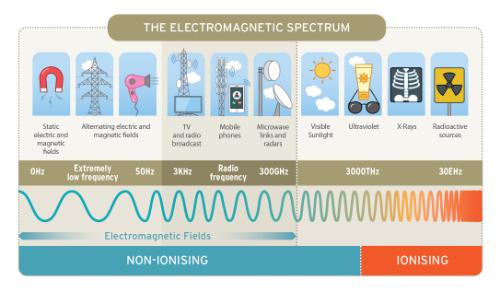Electromagnetic fields (EMF) together with optical radiation, which includes infrared, visible light, and ultraviolet radiation, collectively make up the non-ionising radiation (NIR) spectrum. This type of radiation does not have enough energy to break up (ionise) atoms or molecules. It is therefore different to ionising radiation, such as X-rays or radioactive sources, which can break up molecules and is known to cause damage to human cells.
EMF are generated by everyday items such as mobile phones and electrical appliances. EMF are intentionally produced and used to transmit information wirelessly over great distances or to heat things such as food. So, we use EMF every time we listen to the radio, watch television, warm up food in a microwave oven or use our mobile phone. EMF are also generated when electricity is produced (e.g. power plants) and distributed (e.g. power lines), and whenever we use an electric appliance at home or in work.
EMF sources also occur in nature and include the earth’s magnetic field, which causes compasses to point north, or the electric fields produced in the atmosphere during lightning storms. EMF are also emitted by the sun, and even by our own bodies.
Depending on the frequency, EMF can be divided into three categories: static electric and magnetic fields (0 Hz), extremely-low frequency (ELF) fields (1 Hz – 3 kHz) and radiofrequency (RF) fields (3 kHz – 300 GHz), which includes microwaves (300 MHz - 300 GHz).

Learn more about EMF & NIR